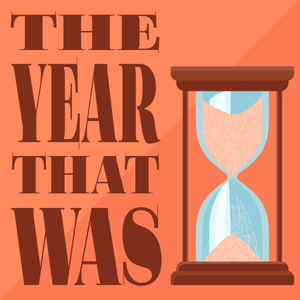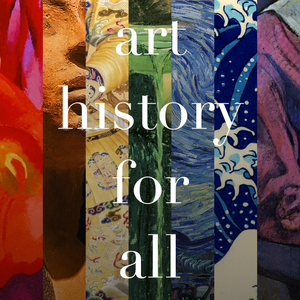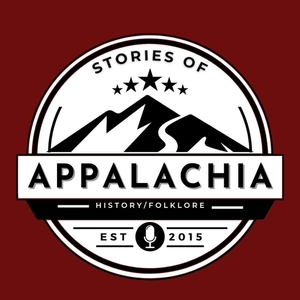
Do You Expect Us to Turn Back Now: Alice Paul and the Fight for Woman Suffrage
06/28/20 • 55 min
Women in the United States began fighting for the right to vote in 1848, and by 1910 they had achieved a few hard-won victories. But success nationwide seemed out of reach. Then Alice Paul arrived on the scene with a playbook of radical protest strategies and an indomitable will. She focused in on one target: the president, Woodrow Wilson. How far would Paul and her fellow suffragists have to go to get Wilson's support?
Dora Lewis was the member of prominent Philadelphia family. She was dedicated fighter for the right of women to vote.
In 1919, Lewis participated in the Watchfires protests, in which suffragists burned the speeches of Woodrow Wilson to reject his hypocricy of speaking about democracy and justice without protecting them for women at home.
The woman suffrage movement in the United States is usually said to have begun at the Seneca Falls Convention in 1848. The Convention, organized by Elizabeth Cady Stanton and several friends and colleagues, produced a Declaration of Sentiments that called for women to "secure for themselves their right to the elective franchise."
Elizabeth Cady Stanton (left) and Susan B. Anthony (right) met in 1851 and become close friends and dedicated fighters for votes for women.
The "New Woman" of the turn of the 19th century was educated, independent, and career-minded. These women were more demanding than previous generations and less concerned about upsetting gender norms.
I joked in this episode about New Women and their bicycles, but this was actually an enormous breakthrough for women. For the first time, women had freedom of movement that opened up a world that been narrowly restricted for previous generations.
Alice Paul was charismatic, magnetic, and impossible to refuse. She was willing to work herself into the hospital and expected the same level of effort from her friends. (She is also, in this photo, wearing an awesome hat.)
Alice Paul spent the years between 1907 and 1909 in the United Kingdom, where she joined the radical suffragette movement. She learned the power of protest in England, as well as the power of her own will.
In 1909, Paul went on a hunger strike in prison and was force fed. This was a horrifying, traumatic experience--a fact that the suffragettes didn't hesitate to leverage in their promotional material.
Paul's first major action back in the United States was the Woman Suffrage Procession of 1913. Scheduled the day before Woodrow Wilson's inauguration, it achieved maximum publicity for the cause. This image was used as the cover of the official procession program.
This photo shows the start of the procession, with attorney Inez Mulholland on horseback.
Paul and other organizers intended to segregate African-American marchers to the end of the parade, but Ida B. Wells-Barnett had no intention of being segregated. She joined the Illinois delegation halfway along the route.
Massive crowds viewed the parade. Without adequate police monitoring, the crowd got out of control, spilled into the street, and began harassing the marchers.
In 1917, the Silent Sentinels began protesting daily at the White House. They carried banners demanding the president take action on women's right to vote.
For several months, the protests were peaceful. But Paul began cranking up the tension in the summer, and D.C. police began arresting and detaining the protesters.
Eventually, suffragists were sentenced to time at Occoquan Workhouse a grim, remote facility. Here several suffragists, including Dora Lewis, pose in their prison uniforms.
Suffragist prisoners began protests in prison, refusing to wear uniforms or do assigned work. Some, including Alice Paul, went on hunger strikes. Prison guards reacted with increasing violence. Here one of the suffragists has to be helped to a car after a harrowing stay at Occoquan.
At the same time the members of the NWP were protesting daily at the White House, members of the rival organization NAWSA were conducting a massive campaign for suffrage in New York. They won the vote for 2 million women and reinforced the nationwide conviction that the time had come for a federal amendment.
The New York campaign was one of the most inclusive in suffrage history. NAWSA partnered with both the Wage Earner's Suffrage League and the New York City Colored Woman Suffrage Club. African-American suffrage clubs were popular in northern states; this image is of such a group. (I was unable to figure out exactly where these women were from.)
After the House of Representatives passed the federal woman suffrage amendment in 1918, the NWP and NAWSA set aside their differences and worked together to lobby Senators for votes for women. They developed an early form of a database in an index card system that tracked each Senator's friends, memberships, and donors. They also logged notes of each meeting wit...
Women in the United States began fighting for the right to vote in 1848, and by 1910 they had achieved a few hard-won victories. But success nationwide seemed out of reach. Then Alice Paul arrived on the scene with a playbook of radical protest strategies and an indomitable will. She focused in on one target: the president, Woodrow Wilson. How far would Paul and her fellow suffragists have to go to get Wilson's support?
Dora Lewis was the member of prominent Philadelphia family. She was dedicated fighter for the right of women to vote.
In 1919, Lewis participated in the Watchfires protests, in which suffragists burned the speeches of Woodrow Wilson to reject his hypocricy of speaking about democracy and justice without protecting them for women at home.
The woman suffrage movement in the United States is usually said to have begun at the Seneca Falls Convention in 1848. The Convention, organized by Elizabeth Cady Stanton and several friends and colleagues, produced a Declaration of Sentiments that called for women to "secure for themselves their right to the elective franchise."
Elizabeth Cady Stanton (left) and Susan B. Anthony (right) met in 1851 and become close friends and dedicated fighters for votes for women.
The "New Woman" of the turn of the 19th century was educated, independent, and career-minded. These women were more demanding than previous generations and less concerned about upsetting gender norms.
I joked in this episode about New Women and their bicycles, but this was actually an enormous breakthrough for women. For the first time, women had freedom of movement that opened up a world that been narrowly restricted for previous generations.
Alice Paul was charismatic, magnetic, and impossible to refuse. She was willing to work herself into the hospital and expected the same level of effort from her friends. (She is also, in this photo, wearing an awesome hat.)
Alice Paul spent the years between 1907 and 1909 in the United Kingdom, where she joined the radical suffragette movement. She learned the power of protest in England, as well as the power of her own will.
In 1909, Paul went on a hunger strike in prison and was force fed. This was a horrifying, traumatic experience--a fact that the suffragettes didn't hesitate to leverage in their promotional material.
Paul's first major action back in the United States was the Woman Suffrage Procession of 1913. Scheduled the day before Woodrow Wilson's inauguration, it achieved maximum publicity for the cause. This image was used as the cover of the official procession program.
This photo shows the start of the procession, with attorney Inez Mulholland on horseback.
Paul and other organizers intended to segregate African-American marchers to the end of the parade, but Ida B. Wells-Barnett had no intention of being segregated. She joined the Illinois delegation halfway along the route.
Massive crowds viewed the parade. Without adequate police monitoring, the crowd got out of control, spilled into the street, and began harassing the marchers.
In 1917, the Silent Sentinels began protesting daily at the White House. They carried banners demanding the president take action on women's right to vote.
For several months, the protests were peaceful. But Paul began cranking up the tension in the summer, and D.C. police began arresting and detaining the protesters.
Eventually, suffragists were sentenced to time at Occoquan Workhouse a grim, remote facility. Here several suffragists, including Dora Lewis, pose in their prison uniforms.
Suffragist prisoners began protests in prison, refusing to wear uniforms or do assigned work. Some, including Alice Paul, went on hunger strikes. Prison guards reacted with increasing violence. Here one of the suffragists has to be helped to a car after a harrowing stay at Occoquan.
At the same time the members of the NWP were protesting daily at the White House, members of the rival organization NAWSA were conducting a massive campaign for suffrage in New York. They won the vote for 2 million women and reinforced the nationwide conviction that the time had come for a federal amendment.
The New York campaign was one of the most inclusive in suffrage history. NAWSA partnered with both the Wage Earner's Suffrage League and the New York City Colored Woman Suffrage Club. African-American suffrage clubs were popular in northern states; this image is of such a group. (I was unable to figure out exactly where these women were from.)
After the House of Representatives passed the federal woman suffrage amendment in 1918, the NWP and NAWSA set aside their differences and worked together to lobby Senators for votes for women. They developed an early form of a database in an index card system that tracked each Senator's friends, memberships, and donors. They also logged notes of each meeting wit...
Previous Episode

Flu Fences and Chin Sails: Answering New Questions about the Spanish Flu
Living through the COVID-19 pandemic raises all sorts of new questions about the Spanish Flu pandemic of 1918-1919. This episode seeks to answer those questions. We look at the multiple waves of the flu, popular home remedies, who went to the hospital and who stayed home, how the federal government responded to the outbreak, the effect on the economy, resistance to face masks, and how the flu shaped the Roaring Twenties.
Correction: In this episode I state that Arthur Conan Doyle stopped writing mysteries after the flu pandemic. This is simply not true. Doyle published numerous mysteries, including several Sherlock Holmes stories, between 1919 and his death in 1930. My apologies for the error, and thanks to the listener who caught it.
Heroic efforts went into creating a vaccine for Pfieffer's Bacillus, which was believed by many doctors to cause the Spanish Flu. These efforts were all in vain, since Pfeiffer's Bacillus is a fairly common bacteria and not the cause of the flu. The actual cause would not be understood until the existence of viruses was proven in the late 1930s.
The Spanish Flu hit in three waves, in the the spring of 1918, the fall of 1918, and the spring of 1919. There is no evidence that the relaxing of social distancing and/or quarantines triggered the second wave. It is more likely that the virus mutated into a more easily transmitted and more deadly form over the summer. However, the third wave can be linked to relaxed social distancing.
Dr. Kilmer's Swamp Root was a popular patent medicine used to treat the flu. So were onions and Vick's Vapo-Rub.
Nurses played an enormous role during the Spanish Flu, perhaps a greater role than doctors, since recovery was largely the matter of careful nursing. A severe shortage of nurses put a huge burden on those trying to treat patients.
The American health system was strictly segregated in 1918-1919, and nurses of color struggled to treat the patients that overwhelmed the small and underfunded African-American hospitals.
There was no precedent in 1918 for the federal government to play anything other than a coordinating and research role during the Spanish Flu. But the situation was so dire that states and cities begged for help. Surgeon General Rupert Blue seemed unable to rise to the challenge.
The Surgeon's General's advice on how to avoid the flu was distributed widely but offered little in real help and failed to acknowledge the severity of the situation.
The 1918 mid-term election went ahead as planned, but in parts of the west, polling places were unable to open because too many workers were sick with the flu.
Public campaigns urged individuals to cover their faces when coughing or sneezing and to avoid shaking hands. If this cartoon is any indication, some people thought the efforts were extreme.
Cities railed at residents to stop spitting on the street. This was an enormous problem, although this warning seems particularly stark.
Masks were adopted across the country, and some cities mandated their use. The masks became a symbol of the disease. This cartoonist pokes fun at their ubiquity by proposing new styles soon to come out of the Paris fashion houses.
San Francisco required residents and visitors to wear face masks, and initially compliance was high. Red Cross workers sold masks at ferry terminals and on the street.
But people soon tired of wearing masks, or wore them slung around their necks. Soon police and public health officers were busy fining and arresting scofflaws.
Crowds packed the Civic Auditorium for a boxing match in November 1918, and a photographer snapped this image of hundreds of San Franciscans without a mask in sight. Dozens of city leaders were fined for violated the mask ordinance. The ordinance was lifted a few days later.
However, the ordinance was re-imposed in January when the flu returned to San Francisco. This time, opposition to masks was not just heated but organized. An anti-mask league held a meeting to which up to 5000 people attended.
Violet Harris was 15 years old and living in Seattle when the flu closed schools. She kept a diary that gives a sense of life during the shut down.
Some rumors traced the flu pandemic to German scientists and claimed the disease was spread by German submarines. This Brazilian cartoon conveys in this a rather grim way.
Hundreds of thousands of children were left orphaned by the Spanish Flu. This photo shows a group of children who lost their families when the flu raged through the Bristol Bay region of Alaska.
Links:
Next Episode

The Last Night of the Bubbling Glass: The Passage of the 18th Amendment
By 1914, the temperance movement had achieved significant gains in its goal to outlaw the sale of alcohol in the United States. But every push for nationwide prohibition had failed. Would the war--and the accompanying anti-German hysteria--give the Anti-Saloon League enough power to cross the finish line? Was a golden age of sobriety waiting on the other side?
The Temperance Movement began in the 1840s and gained significant momentum through the rest of the century. Women were major leaders in the movement, with many pledging to never let the lips that touch liquor touch theirs. Unfortunately, this seemed to have little effect.
In the second half of the 19th century, an influx of immigrants from beer-loving countries, including Germany and Ireland, dramatically increased the consumption of beer in the United States. German brewers arrived to meet the demand. The most successful among these brewers was Adolphus Busch. As owner of Anheuser-Busch, he built a massive, vertically integrated operation that controlled every aspect of beer production and distribution, from mining the coal that fueled the brewery to building the refrigerated railcars to deliver the beer to Anheuser-Busch owned saloons.
Saloons were more than watering holes. They were hubs for the entire community and played important roles in the lives of patrons, especially when those patrons were recent immigrants.
Pictured here is a saloon in Wisconsin. Notice the little boy sitting at the table with his own beer glass. Boys often accompanied their fathers to saloons. Women and girls, however, were not welcome, and a woman who stepped in a saloon ruined her reputation.
Here's another saloon, this one from Michigan. In a saloon, men could meet friends, participate in local politics, eat a free lunch, take a bath, find a job, get his mail and pawn his watch.
By 1900, most saloons were "tied houses." That is, they were tied to, if not actually owned by, breweries. In exchange for agreeing to sell only one brand of beer, a barkeeper would receive cash for his licensing fees, an inventory of glassware, and the furnishings for the saloon, including the pool tables and the mirrors on the walls.
This photo shows a Miller bar in Chicago.
Temperance activists believed saloons were evil through and through. This cartoon, probably from the mid- to late-19th century, shows children desperately calling for the father, who stands in his natty coat and top hat at the bar. The bartender is a grinning skull, and another skull atop crossed bottles decorates in the bar. In the background, a brawl has broken out. Clearly, nothing good happens at a saloon!
Women's rights activists in particular believed that alcohol was the cause of domestic violence. In this illustration, a drunken man takes a swing at his wife as his children cling to his legs. Many woman suffragists believed that prohibition would stop violence in the home.
The Anti-Saloon League became a force to be reckoned with by organizing all of the anti-alcohol groups. The League was led by Wayne Wheeler, a genial midwesterner that author Daniel Okrent noted resembled Ned Flanders. In fact, Wheeler was a passionate, focused organizer with a backbone of steel who could make or break political careers.
Breweries tried reframe beer as a health-giving, nourishing beverage. The Saskatoon Brewing Company tried to sell their beer as "liquid bread."
Knickerbocker Beer ran ads declaring "Beer is Food" and claiming that beer was not only "a wonderful aid to digestion" and a "valuable source of energy" but also "a mainstay of practical temperance."
An Anti-Prohibition coalition produced this ad, showing a fat and happy baby drinking a stein of beer. No one was convinced by any of these campaigns.
Once the United States entered World War I, a new argument began to be made against the alcohol industry: it wasted food and fuel. Americans were called upon to save food for the military, as well as for the British, French and Belgians. The Anti-Saloon League argued that the alcohol industry wasted tons of food and fuel.
In this cartoon, Uncle Sam puts up posters calling to save food and fuel while the saloon tosses out barrels not only of goods but also of "wasted manhood."
"Non-essential" was an insult during the war--anything non-essential to winning the war was useless and to be despised. Here a woman clad in an American flag hurls the word at a fat man identified as "Booze."
In late 1917, riding the wave of anti-alcohol sentiment, the Dry alliance pushed the 18th Amendment through Congress. It went to the states for ratification.
The Anti-Saloon League coordinated the ratification fight with an attack on the United States Brewers Association and an immigrant association it had long backed, the German American Alliance. The League convinced the Senate, a...
If you like this episode you’ll love
Episode Comments
Generate a badge
Get a badge for your website that links back to this episode
<a href="https://goodpods.com/podcasts/the-year-that-was-40470/do-you-expect-us-to-turn-back-now-alice-paul-and-the-fight-for-woman-s-1829686"> <img src="https://storage.googleapis.com/goodpods-images-bucket/badges/generic-badge-1.svg" alt="listen to do you expect us to turn back now: alice paul and the fight for woman suffrage on goodpods" style="width: 225px" /> </a>
Copy




